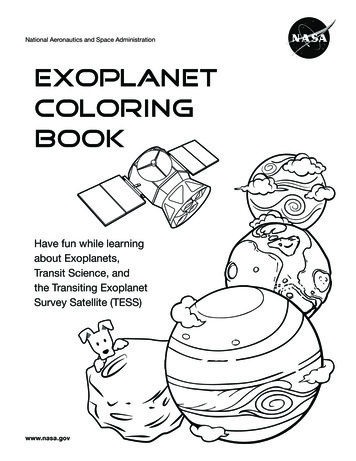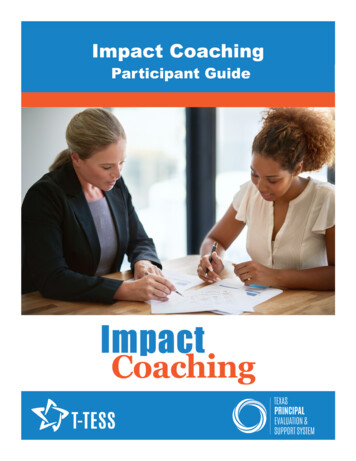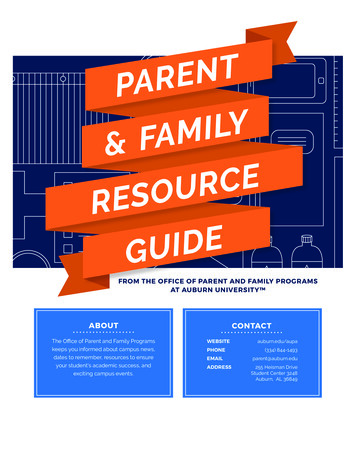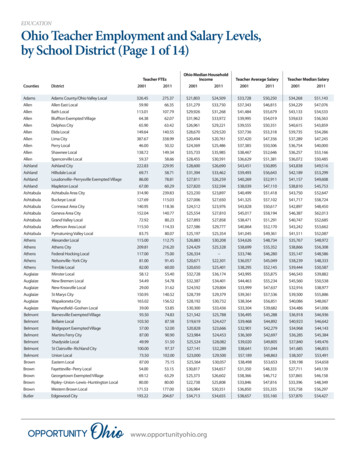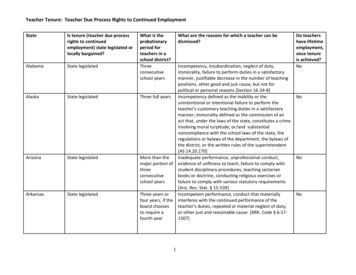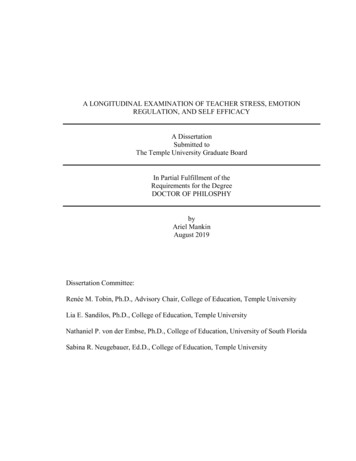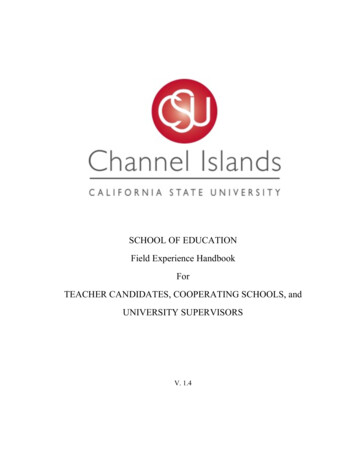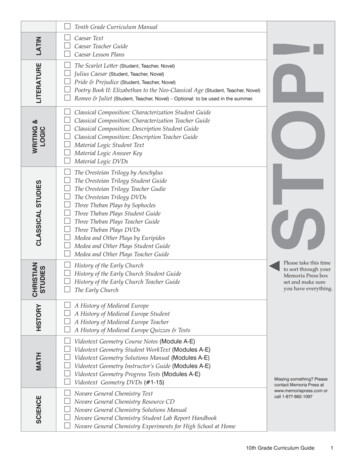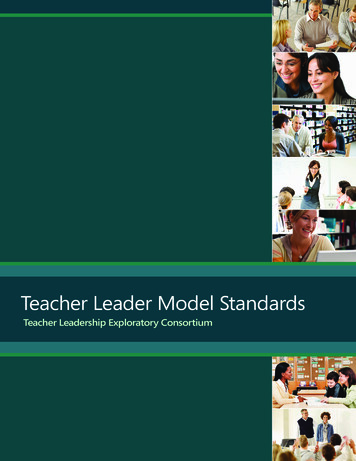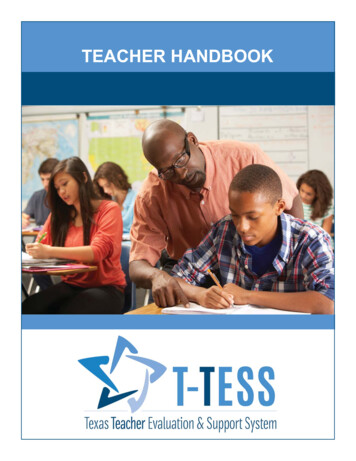
Transcription
TEACHER HANDBOOK
IntroductionT-TESS is the Texas recommended appraisal process designed to evaluate teachers andestablish a system of support. During the spring of 2014, a steering committee finalized thedevelopment of this new evaluation system which directly correlates to the new Texas TeacherStandards outlined in Texas Administrative Code, Chapter 149. These standards inform thetraining, appraisal, and professional development of teachers, define a set of professionalindicators that allow for a common understanding of and vocabulary for desired teachingpractices, and measure teachers' pedagogy and professional responsibilities.The comprehensive T-TESS rubric includes specific dimensions, descriptors and performancelevels. An in-depth understanding of how their performance will be measured using this rubric isessential for teachers to thoroughly engage in T-TESS. Ongoing, systematic rollout processesand exposure to the rubric are critical to ensure that teachers have an opportunity to 'unwrap' thedimensions, create a pool of shared meaning and personally gather data to move from the currentto desired levels of performance. Understanding the dimensions in isolation does not guaranteethat all teachers will accurately and consistently implement them. Teachers also should see howeach dimension is effectively represented in actual instructional practice to understand how theyare accurately applied in multiple instructional contexts. Schools should establish processeswhich promote and safeguard time for this type of learning to occur. On campuses where theevaluation process truly leads to improved instruction and student performance, continuousimprovement is an accepted norm and structures are established to support a community oflearners.This handbook emphasizes that it is the responsibility of every educator to consistently holdthemselves to a high standard for individual development and performance. Educators also havea responsibility to identify methods to collaborate with other educational professionals within andbeyond the school so they can engage in purposeful and targeted professional learningopportunities, seek feedback, and refine practices. The T-TESS Rubric provides the framework todefine and demonstrate how the domains, dimensions and descriptors support teachers as theyimplement strategies in ways that address specific student learning needs. It is, therefore,essential for administrators, teachers, teacher leaders, and other instructional staff to understandall aspects of the T-TESS Rubric and how it describes teaching that leads to increased studentperformance. Using this handbook as a springboard for conversations and incorporating districtand campus-level context is the key to creating consistency and common understandings withinand among teacher teams.While many instructional strategies may be considered "proven best practices," consistent, highquality implementation of these strategies is necessary to positively impact student performance.The evaluation system is intended to focus on quality planning, instructional delivery, and alearning environment which collectively maximizes teaching and learning. TEA2/10/2022T-TESS Teacher Handbook1
Texas Teacher StandardsTexas Administrative Code, Chapter 149.1001 - Texas TeacherStandards.Purpose: The standards identified in this section are performance standards to be used toinform the training, appraisal, and professional development of teachers.Standard 1. Instructional Planning and Delivery. Teachers demonstrate their understanding ofinstructional planning and delivery by providing standards-based, data-driven, differentiatedinstruction that engages students, makes appropriate use of technology, and makes learningrelevant for today's learners.A. Teachers design clear, well organized, sequential lessons that build on students' priorknowledge.(i) Teachers develop lessons that build coherently toward objectives based on course content,curriculum scope and sequence, and expected student outcomes.(ii) Teachers effectively communicate goals, expectations, and objectives to help all studentsreach high levels of achievement.(iii) Teachers connect students' prior understanding and real-world experiences to new contentand contexts, maximizing learning opportunities.B. Teachers design developmentally appropriate, standards-driven lessons that reflect evidencebased best practices.(i) Teachers plan instruction that is developmentally appropriate, is standards driven, andmotivates students to learn.(ii) Teachers use a range of instructional strategies, appropriate to the content area, to makesubject matter accessible to all students.(iii) Teachers use and adapt resources, technologies, and standards-aligned instructionalmaterials to promote student success in meeting learning goals.C. Teachers design lessons to meet the needs of diverse learners, adapting methods whenappropriate.(i) Teachers differentiate instruction, aligning methods and techniques to diverse studentneeds, including acceleration, remediation, and implementation of individual education plans.(ii) Teachers plan student groupings, including pairings and individualized and small-groupinstruction, to facilitate student learning.(iii) Teachers integrate the use of oral, written, graphic, kinesthetic, and/or tactile methods toteach key concepts.D. Teachers communicate clearly and accurately and engage students in a manner thatencourages students' persistence and best efforts. TEA2/10/2022T-TESS Teacher Handbook2
(i) Teachers ensure that the learning environment features a high degree of studentengagement by facilitating discussion and student-centered activities as well as leading directinstruction.(ii) Teachers validate each student's comments and questions, utilizing them to advancelearning for all students.(iii) Teachers encourage all students to overcome obstacles and remain persistent in the faceof challenges, providing them with support in achieving their goals.E. Teachers promote complex, higher-order thinking, leading class discussions and activities thatprovide opportunities for deeper learning.(i) Teachers set high expectations and create challenging learning experiences for students,encouraging them to apply disciplinary and cross-disciplinary knowledge to real-worldproblems.(ii) Teachers provide opportunities for students to engage in individual and collaborative criticalthinking and problem solving.(iii) Teachers incorporate technology that allows students to interact with the curriculum inmore significant and effective ways, helping them reach mastery.F. Teachers consistently check for understanding, give immediate feedback, and make lessonadjustments as necessary.(i) Teachers monitor and assess student progress to ensure that their lessons meet students'needs.(ii) Teachers provide immediate feedback to students in order to reinforce their learning andensure that they understand key concepts.(iii) Teachers adjust content delivery in response to student progress through the use ofdevelopmentally appropriate strategies that maximize student engagement.Standard 2. Knowledge of Students and Student Learning. Teachers work to ensure highlevels of learning, social-emotional development, and achievement outcomes for all students,taking into consideration each student's educational and developmental backgrounds andfocusing on each student's needs.A. Teachers demonstrate the belief that all students have the potential to achieve at high levelsand support all students in their pursuit of social-emotional learning and academic success.(i) Teachers purposefully utilize learners' individual strengths as a basis for academic andsocial-emotional growth.(ii) Teachers create a community of learners in an inclusive environment that views differencesin learning and background as educational assets.(iii) Teachers accept responsibility for the growth of all of their students, persisting in theirefforts to ensure high levels of growth on the part of each learner. TEA2/10/2022T-TESS Teacher Handbook3
B. Teachers acquire, analyze, and use background information (familial, cultural, educational,linguistic, and developmental characteristics) to engage students in learning.(i) Teachers connect learning, content, and expectations to students' prior knowledge, lifeexperiences, and interests in meaningful contexts.(ii) Teachers understand the unique qualities of students with exceptional needs, includingdisabilities and giftedness, and know how to effectively address these needs throughinstructional strategies and resources.(iii) Teachers understand the role of language and culture in learning and know how to modifytheir practices to support language acquisition so that language is comprehensible andinstruction is fully accessible.C. Teachers facilitate each student's learning by employing evidence-based practices andconcepts related to learning and social-emotional development.(i) Teachers understand how learning occurs and how learners develop, construct meaning,and acquire knowledge and skills.(ii) Teachers identify readiness for learning and understand how development in one area mayaffect students' performance in other areas.(iii) Teachers apply evidence-based strategies to address individual student learning needsand differences, adjust their instruction, and support the learning needs of each student.Standard 3. Content Knowledge and Expertise. Teachers exhibit a comprehensiveunderstanding of their content, discipline, and related pedagogy as demonstrated through thequality of the design and execution of lessons and their ability to match objectives and activities torelevant state standards.A. Teachers understand the major concepts, key themes, multiple perspectives, assumptions,processes of inquiry, structure, and real-world applications of their grade-level and subject-areacontent.(i) Teachers have expertise in how their content vertically and horizontally aligns with thegrade-level/subject-area continuum, leading to an integrated curriculum across grade levelsand content areas.(ii) Teachers identify gaps in students' knowledge of subject matter and communicate withtheir leaders and colleagues to ensure that these gaps are adequately addressed across gradelevels and subject areas.(iii) Teachers keep current with developments, new content, new approaches, and changingmethods of instructional delivery within their discipline.B. Teachers design and execute quality lessons that are consistent with the concepts of theirspecific discipline, are aligned to state standards, and demonstrate their content expertise.(i) Teachers organize curriculum to facilitate student understanding of the subject matter.(ii) Teachers understand, actively anticipate, and adapt instruction to address common TEA2/10/2022T-TESS Teacher Handbook4
misunderstandings and preconceptions.(iii) Teachers promote literacy and the academic language within the discipline and makediscipline-specific language accessible to all learners.C. Teachers demonstrate content-specific pedagogy that meets the needs of diverse learners,utilizing engaging instructional materials to connect prior content knowledge to new learning.(i) Teachers teach both the key content knowledge and the key skills of the discipline.(ii) Teachers make appropriate and authentic connections across disciplines, subjects, andstudents' real-world experiences.Standard 4. Learning Environment. Teachers interact with students in respectful ways at alltimes, maintaining a physically and emotionally safe, supportive learning environment that ischaracterized by efficient and effective routines, clear expectations for student behavior, andorganization that maximizes student learning.A. Teachers create a mutually respectful, collaborative, and safe community of learners by usingknowledge of students' development and backgrounds.(i) Teachers embrace students' backgrounds and experiences as an asset in their learningenvironment.(ii) Teachers maintain and facilitate respectful, supportive, positive, and productive interactionswith and among students.(iii) Teachers establish and sustain learning environments that are developmentallyappropriate and respond to students' needs, strengths, and personal experiences.B. Teachers organize their classrooms in a safe and accessible manner that maximizes learning.(i) Teachers arrange the physical environment to maximize student learning and to ensure thatall students have access to resources.(ii) Teachers create a physical classroom set-up that is flexible and accommodates thedifferent learning needs of students.C. Teachers establish, implement, and communicate consistent routines for effective classroommanagement, including clear expectations for student behavior.(i) Teachers implement behavior management systems to maintain an environment where allstudents can learn effectively.(ii) Teachers maintain a strong culture of individual and group accountability for classexpectations.(iii) Teachers cultivate student ownership in developing classroom culture and norms.D. Teachers lead and maintain classrooms where students are actively engaged in learning asindicated by their level of motivation and on-task behavior.(i) Teachers maintain a culture that is based on high expectations for student performance and TEA2/10/2022T-TESS Teacher Handbook5
encourages students to be self-motivated, taking responsibility for their own learning.(ii) Teachers maximize instructional time, including managing transitions.(iii) Teachers manage and facilitate groupings in order to maximize student collaboration,participation, and achievement.(iv) Teachers communicate regularly, clearly, and appropriately with parents and families aboutstudent progress, providing detailed and constructive feedback and partnering with families infurthering their students' achievement goals.Standard 5. Data-Driven Practice. Teachers use formal and informal methods to assess studentgrowth aligned to instructional goals and course objectives and regularly review and analyzemultiple sources of data to measure student progress and adjust instructional strategies andcontent delivery as needed.A. Teachers implement both formal and informal methods of measuring student progress.(i) Teachers gauge student progress and ensure student mastery of content knowledge andskills by providing assessments aligned to instructional objectives and outcomes that areaccurate measures of student learning.(ii) Teachers vary methods of assessing learning to accommodate students' learning needs,linguistic differences, and/or varying levels of background knowledge.B. Teachers set individual and group learning goals for students by using preliminary data andcommunicate these goals with students and families to ensure mutual understanding ofexpectations.(i) Teachers develop learning plans and set academic as well as social-emotional learninggoals for each student in response to previous outcomes from formal and informalassessments.(ii) Teachers involve all students in self-assessment, goal setting, and monitoring progress.(iii) Teachers communicate with students and families regularly about the importance ofcollecting data and monitoring progress of student outcomes, sharing timely andcomprehensible feedback so they understand students' goals and progress.C. Teachers regularly collect, review, and analyze data to monitor student progress.(i) Teachers analyze and review data in a timely, thorough, accurate, and appropriate manner,both individually and with colleagues, to monitor student learning.(ii) Teachers combine results from different measures to develop a holistic picture of students'strengths and learning needs.D. Teachers utilize the data they collect and analyze to inform their instructional strategies andadjust short- and long-term plans accordingly.(i) Teachers design instruction, change strategies, and differentiate their teaching practices toimprove student learning based on assessment outcomes. TEA2/10/2022T-TESS Teacher Handbook6
(ii) Teachers regularly compare their curriculum scope and sequence with student data toensure they are on track and make adjustments as needed.Standard 6. Professional Practices and Responsibilities. Teachers consistently holdthemselves to a high standard for individual development, pursue leadership opportunities,collaborate with other educational professionals, communicate regularly with stakeholders,maintain professional relationships, comply with all campus and school district policies, andconduct themselves ethically and with integrity.A. Teachers reflect on their teaching practice to improve their instructional effectiveness andengage in continuous professional learning to gain knowledge and skills and refine professionaljudgment.(i) Teachers reflect on their own strengths and professional learning needs, using thisinformation to develop action plans for improvement.(ii) Teachers establish and strive to achieve professional goals to strengthen their instructionaleffectiveness and better meet students' needs.(iii) Teachers engage in relevant, targeted professional learning opportunities that align withtheir professional growth goals and their students' academic and social-emotional needs.B. Teachers collaborate with their colleagues, are self-aware in their interpersonal interactions,and are open to constructive feedback from peers and administrators.(i) Teachers seek out feedback from supervisors, coaches, and peers and take advantage ofopportunities for job-embedded professional development.(ii) Teachers actively participate in professional learning communities organized to improveinstructional practices and student learning.C. Teachers seek out opportunities to lead students, other educators, and community memberswithin and beyond their classrooms.(i) Teachers clearly communicate the mission, vision, and goals of the school to students,colleagues, parents and families, and other community members.(ii) Teachers seek to lead other adults on campus through professional learning communities,grade- or subject-level team leadership, committee membership, or other opportunities.D. Teachers model ethical and respectful behavior and demonstrate integrity in all situations.(i) Teachers adhere to the educators' code of ethics in §247.2 of this title (relating to Code ofEthics and Standard Practices for Texas Educators), including following policies andprocedures at their specific school placement(s).(ii) Teachers communicate consistently, clearly, and respectfully with all members of thecampus community, including students, parents and families, colleagues, administrators, andstaff.(iii) Teachers serve as advocates for their students, focusing attention on students' needs andconcerns and maintaining thorough and accurate student records. TEA2/10/2022T-TESS Teacher Handbook7
Texas Teacher Standards in Review1. How are campus professionals engaged in ongoing study and application of the TexasTeacher Standards?2. How are these standards used to guide professional expectations for teachers andcontinuously ensure that quality practices are embraced and implemented?3. How are the standards used in conjunction with the T-TESS Rubric to self-assess anddevelop plans for improvement?A Culture of Continuous ImprovementGiven that student performance expectations continue to increase, effective schools establishcultures of continuous improvement where individuals are learning, growing and contributing tocampus-wide success. Through ongoing communication, collaboration, information sharing,assessments, and acknowledgment of strengths and needs, individuals and teams canaccomplish both personal and organizational goals. While T-TESS is used to evaluate teacherspecific knowledge, skills and responsibilities, continuous improvement processes ideally occur atvarying levels within the organization: personal growth focused on instructional improvement atthe classroom level; those focused on the team or department level; and those addressingsystem-wide growth with a collective impact on student performance. To yield these results, thiswork is planned and implemented in a thoughtful, rigorous, and transparent manner so that it isjob-embedded, tied to the domains, dimensions, descriptors and performance levels of the TTESS Rubric, and aligned with the goal-setting and professional development processes.Four Domains of the T-TESS RubricThe T-TESS Rubric includes four domains: Planning, Instruction, Learning Environment, andProfessional Practices and Responsibilities. The domains and correlating dimensions are shownin the chart below. Individual rubrics are established for each dimension of the T-TESS Rubric toinclude specific descriptors of practices for each of the performance levels - distinguished,accomplished, proficient, developing, and improvement needed.This handbook reviews the elements of each dimension, including how the dimensions arerepresented in classroom practices. This information is intended to initiate teacher discussionsregarding the practical application of the knowledge and skills embedded in the rubric withextensions and other concrete examples for classroom and team meetings determined at theschool level. Figure 1 outlines the four domains of the T-TESS Rubric and the specificdimensions for each. TEA2/10/2022T-TESS Teacher Handbook8
Figure 1. Four Domains of the T-TESS RubricPlanningInstructionLearning EnvironmentProfessionalPractices andResponsibilities Standards and Alignment Data and Assessments Knowledge of Students Activities Achieving Expectations Content Knowledge and Expertise Communication Differentiation Classroom Environment, Routines andProcedures Managing Student Behavior Classroom Culture Professional Demeanor and Ethics Goal Setting Professional Development School Community InvolvementPlanning DomainThis section provides guidance regarding the planning domain and correlating four dimensions: Standards and Alignment Data and Assessments Knowledge of Students ActivitiesEffective planning begins with measurable and explicit learning outcomes aligned to the TEKSand other relevant standards for learning. Planning is initially based on three driving questions: TEA2/10/2022T-TESS Teacher Handbook9
(1) What do I want students to know and be able to do as a result ofthis lesson?(2) How will the students be engaged in the learning to addresstheir individual needs and interests?(3) How will I assess that the students have demonstrated masteryof the identified knowledge, skills, and concepts in the lesson?It is evident that the four planning dimensions are directly embedded in these questions toprovoke rich discussions during team planning meetings and clarify the planning phase.As a result of quality planning, lessons have a clear beginning, middle and end, and arescaffolded to follow a logical progression of basic to complex. Lessons connect students' priorknowledge and understanding to new content and contexts, including real-world applications, andconsistently accommodate individual students' needs. They also include targeted large- andsmall-group instructional strategies, technology and resources which are appropriate tothe content area, and before making the subject matter accessible to all students. A welldesigned lesson, where appropriate planning time has been devoted, contributes to higherquality, student-centered learning experiences that are challenging and an efficient andeffective learning environment where students assume responsibility for their own learning.During classroom instruction, this allows teachers to focus on the execution of the lesson andthe impact on student outcomes.Another way to think about this is with the relationship among content, process and context,as depicted in Figure 2.Figure 2. Relationship Among Content, Process and ContextWhat do I want students to know and be able to do as a result of thislesson? Which curriculum standards will be addressed?ContentHow will this be taught to addressindividual needs, and interests?Which instructional strategies havea high probability of impactingstudent performance? TEA2/10/2022ProcessContextT-TESS Teacher HandbookHow will information be presented infamiliar contexts and those in which thecontent is relevant and useful? Howwill it make sense to students in theirown frame of reference?10
Evidence and data for the planning domain and dimensions are collected over the course of theyear during individual and team planning meetings, through the review of lesson plans andartifacts, with student data management systems, pre-conferences and other applicable means.Effective planning is critical to the overall design and delivery of curriculum, instruction andassessments and how these three elements work together.Standards and AlignmentDimension 1.1The teacher designs clear, well-organized, sequential lessons that reflect best practice, alignwith the standards, and are appropriate for diverse learners.The teacher designs clear, well-organized,DIMENSION 1.1 sequential lessons that reflect bestpractice, align with standards and are appropriate for diverse learners.Standards Basis: 1A, 1B, 3A, 3B, 3CStandards and AlignmentPLA N N IN HER-CENTEREDACTIONSSTUDENT-CENTERED ACTIONSI n s t r u c t io n a lP la n n in g I n c lu d e s :Improvement NeededI n s t r u c t io n a lP la n n in g I n c lu d e s :I n s t r u c t io n a lP la n n in g I n c lu d e s :I n s t r u c t io n a lP la n n in g I n c lu d e s :I n s t r u c t io n a lP la n n in g I n c lu d e s : All rigorous and measurable goalsaligned to state content standards. All measurable goals aligned tostate content standards. All goals aligned to state contentstandards. Most goals aligned to statecontent standards. Few goaIs aligned to statecontent standards. All activities, materials andassessments that: All activities, materials andassessments that: All activities, materials andassessments tha t: Most activities, materialsand assessments that: Few activities, materialsand assessments that: are logically sequenced are sequenced are relevant to students are sequenced are sequenced are relevant to students’ priorunderstanding and real-worldapplications are relevant to students’ priorunderstanding provide appropriate time forlesson and lesson closure rarely provide time for lessonand lesson closure integrate other disaplines integrate and reinforce conceptsfrom other disciplines provide appropriate time forstudent work, lesson and lessonclosure fit into the broader unit andcourse objectives sometimes provide appropriatetime for lesson and lessonclosure provide appropriate time forstudent work, student reflection,lesson and lesson closure are appropriate for diverse learners. reinforce broader unit andcourse objectives deepen understanding of broaderunit and course objectives All objectives aligned to thelesson’s goal. are vertically aligned to statestandards are vertically aligned to statestandards Integration of technology whenapplicable. are appropriate for diverselearners are appropriate for diverselearners Objectives aligned and logicallysequenced to the lesson's goaI,providing relevant and enrichingextensions of the lesson Lessons where most objectivesare aligned and sequenced to thelesson’s goal. Lessons where few objectives arealigned and sequenced to thelesson's goal.Possible Sourcesof Evidence: All objectives aligned and logicallysequenced to the lesson's goal. Conferences and Conversationswith the Teacher Formal Observations/Walkthroughs ClassroomArtifacts Student Growth Processes Integration of technology toenhance mastery of goal(s). Integration of techno logy toenhance mastery of goal (s).This dimension focuses on how the lesson is designed to address specific standards, primarilythe Texas Essential Knowledge and Skills (TEKS) in grades kindergarten through high schoolwhich are specific to the grade level and course/subject taught.Content Standards TEATEKS — English (Spanish, where applicable)2/10/2022T-TESS Teacher Handbook11
oEnglish Language Arts and ReadingoMathematicsoScienceoSocial StudiesoLanguages Other Than EnglishoHealth EducationoPhysical EducationoFine ArtsoEconomics with Emphasis on the Free Enterprise SystemoTechnology ApplicationsoCareer DevelopmentoSpanish Language Arts and English as a Second LanguageoCareer and Technical EducationOther Standards English Language Proficiency Standards (ELPS) Prekindergarten Guidelines College and Career Readiness Standards (CCRS) TEKS in SpanishT-TESS Alignment to Practice: The standards describe the knowledge and skills that students should attain and are oftencalled the "what" of "what students should know and be able to do." They address the ways ofthinking, working, communicating, reasoning, problem-solving, and investigating the importantand enduring ideas, concepts, issues and knowledge essential to the discipline withconnections across disciplines. The standards are selected as presented in the district's scope and sequence and are alignedand logically sequenced. The teacher clearly understands what the standards specifically mean for the grade level andsubject taught, including a common understanding among teachers responsible for teachingthese standards. The verbs in the standards define the observable actions expected in classroom instructionand how students are expected to process the content. They are arranged in order ofcomplexity in thinking. TEA2/10/2022T-TESS Teacher Handbook12
The standards and objectives are communicated in multiple ways so that students are clearabout what they are supposed to know and be able to do as a result of the lesson. Technology is purposefully integrated in the lesson design and delivery to enhance the lessonand facilitate students' mastery of the objectives. The standards are spiraled and woven throughout th
T-TESS is the Texas recommended appraisal process designed to evaluate teachers and establish a system of support. During the spring of 2014, a steering committee finalized the . Teachers interact with students in respectful ways at all times,maintaining a physicallyand emotionallysafe, supportive learning environment thatis
